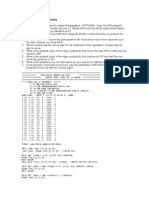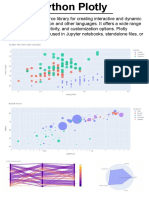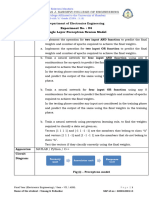Assignment 11
Uploaded by
ankit mahtoAssignment 11
Uploaded by
ankit mahtoAssignment 11 – Quantum Learning
Sandip University - Zeeshan Mawani
In [1]: #import libraries and dataset
import numpy as np
import pandas as pd
import matplotlib.pyplot as plt
import seaborn as sns
from sklearn import preprocessing
from tensorflow.keras.layers import Input, Dense, Dropout, Activation
from tensorflow.keras.models import Model
reg_dataset = pd.read_csv(r'C:\Users\Zeeshan Mawani\Desktop\Jupyter\Class stuff\diamond_price.csv')
In [2]: reg_dataset.head()
Out[2]:
S.No carat cut color clarity depth table price x y z
0 1 0.23 Ideal E SI2 61.5 55.0 326 3.95 3.98 2.43
1 2 0.21 Premium E SI1 59.8 61.0 326 3.89 3.84 2.31
2 3 0.23 Good E VS1 56.9 65.0 327 4.05 4.07 2.31
3 4 0.29 Premium I VS2 62.4 58.0 334 4.20 4.23 2.63
4 5 0.31 Good J SI2 63.3 58.0 335 4.34 4.35 2.75
In [3]: reg_dataset.drop('S.No', axis=1, inplace=True)
reg_dataset.head()
Out[3]:
carat cut color clarity depth table price x y z
0 0.23 Ideal E SI2 61.5 55.0 326 3.95 3.98 2.43
1 0.21 Premium E SI1 59.8 61.0 326 3.89 3.84 2.31
2 0.23 Good E VS1 56.9 65.0 327 4.05 4.07 2.31
3 0.29 Premium I VS2 62.4 58.0 334 4.20 4.23 2.63
4 0.31 Good J SI2 63.3 58.0 335 4.34 4.35 2.75
In [4]: reg_dataset.shape
Out[4]: (53940, 10)
In [5]: reg_dataset.describe()
Out[5]:
carat depth table price x y z
count 53940.000000 53940.000000 53940.000000 53940.000000 53940.000000 53940.000000 53940.000000
mean 0.797940 61.749405 57.457184 3932.799722 5.731157 5.734526 3.538734
std 0.474011 1.432621 2.234491 3989.439738 1.121761 1.142135 0.705699
min 0.200000 43.000000 43.000000 326.000000 0.000000 0.000000 0.000000
25% 0.400000 61.000000 56.000000 950.000000 4.710000 4.720000 2.910000
50% 0.700000 61.800000 57.000000 2401.000000 5.700000 5.710000 3.530000
75% 1.040000 62.500000 59.000000 5324.250000 6.540000 6.540000 4.040000
max 5.010000 79.000000 95.000000 18823.000000 10.740000 58.900000 31.800000
In [6]: # plot price vs. carat
sns.pairplot(reg_dataset, x_vars=['carat'], y_vars = ['price'])
# plot carat vs other Cs
sns.pairplot(reg_dataset, x_vars=['cut', 'clarity', 'color'], y_vars = ['carat'])
plt.show()
In [7]: sns.heatmap(reg_dataset[["carat","cut","color","clarity","depth","table"]].corr(), annot=True)
Out[7]: <AxesSubplot:>
In [8]: list(reg_dataset.cut.unique())
Out[8]: ['Ideal', 'Premium', 'Good', 'Very Good', 'Fair']
In [9]: numeric_data= reg_dataset.drop(['cut','color', 'clarity'], axis=1)
In [10]: cut_onehot = pd.get_dummies(reg_dataset.cut).iloc[:,1:]
color_onehot = pd.get_dummies(reg_dataset.color).iloc[:,1:]
clarity_onehot = pd.get_dummies(reg_dataset.clarity).iloc[:,1:]
In [11]: cut_onehot.head()
Out[11]:
Good Ideal Premium Very Good
0 0 1 0 0
1 0 0 1 0
2 1 0 0 0
3 0 0 1 0
4 1 0 0 0
In [12]: reg_dataset = pd.concat([numeric_data,cut_onehot, color_onehot,clarity_onehot], axis=1)
reg_dataset.head()
Out[12]:
carat depth table price x y z Good Ideal Premium ... H I J IF SI1 SI2 VS1 VS2 VVS1 VVS2
0 0.23 61.5 55.0 326 3.95 3.98 2.43 0 1 0 ... 0 0 0 0 0 1 0 0 0 0
1 0.21 59.8 61.0 326 3.89 3.84 2.31 0 0 1 ... 0 0 0 0 1 0 0 0 0 0
2 0.23 56.9 65.0 327 4.05 4.07 2.31 1 0 0 ... 0 0 0 0 0 0 1 0 0 0
3 0.29 62.4 58.0 334 4.20 4.23 2.63 0 0 1 ... 0 1 0 0 0 0 0 1 0 0
4 0.31 63.3 58.0 335 4.34 4.35 2.75 1 0 0 ... 0 0 1 0 0 1 0 0 0 0
5 rows × 24 columns
In [13]: features = reg_dataset.drop(['price'], axis=1).values
labels = reg_dataset['price'].values
In [14]: from sklearn.model_selection import train_test_split
X_train, X_test, y_train, y_test = train_test_split(features, labels, test_size=0.2, random_state=40)
In [15]: from sklearn.preprocessing import StandardScaler
sc = StandardScaler()
X_train = sc.fit_transform(X_train)
X_test = sc.transform(X_test)
In [16]: input_layer = Input(shape=(features.shape[1],))
l1 = Dense(100, activation='relu')(input_layer)
l2 = Dense(50, activation='relu')(l1)
l3 = Dense(25, activation='relu')(l2)
output = Dense(1)(l3)
In [17]: model = Model(inputs=input_layer, outputs=output)
model.compile(loss="mean_absolute_error" , optimizer="adam", metrics=["mean_absolute_error"])
In [18]: print(model.summary())
Model: "model"
_________________________________________________________________
Layer (type) Output Shape Param #
=================================================================
input_1 (InputLayer) [(None, 23)] 0
dense (Dense) (None, 100) 2400
dense_1 (Dense) (None, 50) 5050
dense_2 (Dense) (None, 25) 1275
dense_3 (Dense) (None, 1) 26
=================================================================
Total params: 8,751
Trainable params: 8,751
Non-trainable params: 0
_________________________________________________________________
None
In [19]: history = model.fit(X_train, y_train, batch_size=2, epochs=20, verbose=1, validation_split=0.2)
17261/17261 [==============================] - 39s 2ms/step - loss: 324.2164 - mean_absolute_error: 324.2164 - val_l
oss: 352.5723 - val_mean_absolute_error: 352.5723
Epoch 15/20
17261/17261 [==============================] - 39s 2ms/step - loss: 322.4259 - mean_absolute_error: 322.4259 - val_l
oss: 363.4964 - val_mean_absolute_error: 363.4964
Epoch 16/20
17261/17261 [==============================] - 39s 2ms/step - loss: 321.3640 - mean_absolute_error: 321.3640 - val_l
oss: 351.7753 - val_mean_absolute_error: 351.7753
Epoch 17/20
17261/17261 [==============================] - 39s 2ms/step - loss: 318.6007 - mean_absolute_error: 318.6007 - val_l
oss: 351.6654 - val_mean_absolute_error: 351.6654
Epoch 18/20
17261/17261 [==============================] - 39s 2ms/step - loss: 317.5522 - mean_absolute_error: 317.5522 - val_l
oss: 360.9181 - val_mean_absolute_error: 360.9181
Epoch 19/20
17261/17261 [==============================] - 39s 2ms/step - loss: 315.9409 - mean_absolute_error: 315.9409 - val_l
oss: 362.9208 - val_mean_absolute_error: 362.9208
Epoch 20/20
17261/17261 [==============================] - 39s 2ms/step - loss: 313.7580 - mean_absolute_error: 313.7580 - val_l
oss: 350.9129 - val_mean_absolute_error: 350.9129
In [20]: from sklearn.metrics import mean_absolute_error
from math import sqrt
pred_train = model.predict(X_train)
print(mean_absolute_error(y_train,pred_train))
pred = model.predict(X_test)
print(mean_absolute_error(y_test,pred))
318.7477203046652
323.489523630563
You might also like
- Connections Between Wind Tonguings and Keyboard Fingerings (1500-1650)No ratings yetConnections Between Wind Tonguings and Keyboard Fingerings (1500-1650)110 pages
- Agroconsultant: Intelligent Crop Recommendation System Using Machine Learning AlgorithmsNo ratings yetAgroconsultant: Intelligent Crop Recommendation System Using Machine Learning Algorithms6 pages
- ML0101EN Clas K Nearest Neighbors CustCat Py v1100% (1)ML0101EN Clas K Nearest Neighbors CustCat Py v111 pages
- Loading The Dataset: First We Load The Dataset and Find Out The Number of Columns, Rows, NULL Values, Etc100% (1)Loading The Dataset: First We Load The Dataset and Find Out The Number of Columns, Rows, NULL Values, Etc8 pages
- Outliers, Hypothesis and Natural Language Processing100% (1)Outliers, Hypothesis and Natural Language Processing7 pages
- Neural Network Based Rainfall Prediction System100% (1)Neural Network Based Rainfall Prediction System6 pages
- Unit V - Classification and Prediction 2020-21100% (1)Unit V - Classification and Prediction 2020-2168 pages
- A Machine Learning Framework For Sport Result PredictionNo ratings yetA Machine Learning Framework For Sport Result Prediction7 pages
- The Application of Machine Learning For Sport Result Prediction A ReviewNo ratings yetThe Application of Machine Learning For Sport Result Prediction A Review49 pages
- Multiple Choice Questions: Net/Set Preparation MCQ On Numerical Analysis by S. M. ChincholeNo ratings yetMultiple Choice Questions: Net/Set Preparation MCQ On Numerical Analysis by S. M. Chinchole25 pages
- Computer Aided Technology Based On Graph Sample and Aggregate Attention Network Optimized For Soccer Teaching and TrainingNo ratings yetComputer Aided Technology Based On Graph Sample and Aggregate Attention Network Optimized For Soccer Teaching and Training18 pages
- Currency Recognition On Mobile Phones Proposed System ModulesNo ratings yetCurrency Recognition On Mobile Phones Proposed System Modules26 pages
- Unsupervised Feature Extraction With Autoencoders For EEG Based Multiclass Motor Imagery BCINo ratings yetUnsupervised Feature Extraction With Autoencoders For EEG Based Multiclass Motor Imagery BCI10 pages
- Applications of Machine Learning To Optimize TennisNo ratings yetApplications of Machine Learning To Optimize Tennis20 pages
- Real-Time Face Detection On A "Dual-Sensor" Smart Camera Using Smooth-Edges TechniqueNo ratings yetReal-Time Face Detection On A "Dual-Sensor" Smart Camera Using Smooth-Edges Technique5 pages
- Face Detection and Recognition Using Image ProcessingNo ratings yetFace Detection and Recognition Using Image Processing43 pages
- Clustering Seasonal Performances of Soccer Teams Based On Situational Score LineNo ratings yetClustering Seasonal Performances of Soccer Teams Based On Situational Score Line6 pages
- SVM (Support Vector Machine) For Classification - by Aditya Kumar - Towards Data Science100% (1)SVM (Support Vector Machine) For Classification - by Aditya Kumar - Towards Data Science28 pages
- Machine Learning in Python Main Developments and T100% (1)Machine Learning in Python Main Developments and T44 pages
- Machine Learning For Parkinson's Disease PredictionNo ratings yetMachine Learning For Parkinson's Disease Prediction8 pages
- Survey of Machine Learning in Phishing Detection ResearchNo ratings yetSurvey of Machine Learning in Phishing Detection Research21 pages
- Scripting (Torque Script) : Concepts and TerminologyNo ratings yetScripting (Torque Script) : Concepts and Terminology41 pages
- Get Veterinary Histology of Domestic Mammals and Birds 5th Edition Hans-Georg Liebich free all chapters100% (10)Get Veterinary Histology of Domestic Mammals and Birds 5th Edition Hans-Georg Liebich free all chapters60 pages
- Order Vyakti Vikas Kendra VS Manoj MisraNo ratings yetOrder Vyakti Vikas Kendra VS Manoj Misra3 pages
- Frictionless Spacecraft Simulator With Unrestricted Three Axis Movement For NanosatsNo ratings yetFrictionless Spacecraft Simulator With Unrestricted Three Axis Movement For Nanosats12 pages
- OB 58 OB Ch12 Leadership and FollowershipNo ratings yetOB 58 OB Ch12 Leadership and Followership26 pages
- Improvement of A Multiphase Flow Model For Wellhead Chokes Under Critical and Subcritical Conditions Using Field DataNo ratings yetImprovement of A Multiphase Flow Model For Wellhead Chokes Under Critical and Subcritical Conditions Using Field Data17 pages
- Composite Beam Design Manual: AISC 360-16No ratings yetComposite Beam Design Manual: AISC 360-1698 pages
- Static Pressure For AHU's and Fans - 21.01.2013No ratings yetStatic Pressure For AHU's and Fans - 21.01.201312 pages
- Indian Facilities Management Services Report-Final50% (2)Indian Facilities Management Services Report-Final51 pages
- Ergonomics Intervention Program To Train Water Measurers (Al-Kayyals) For Work at Foggara Irrigation System in AlgeriaNo ratings yetErgonomics Intervention Program To Train Water Measurers (Al-Kayyals) For Work at Foggara Irrigation System in Algeria8 pages
- Connections Between Wind Tonguings and Keyboard Fingerings (1500-1650)Connections Between Wind Tonguings and Keyboard Fingerings (1500-1650)
- Agroconsultant: Intelligent Crop Recommendation System Using Machine Learning AlgorithmsAgroconsultant: Intelligent Crop Recommendation System Using Machine Learning Algorithms
- Loading The Dataset: First We Load The Dataset and Find Out The Number of Columns, Rows, NULL Values, EtcLoading The Dataset: First We Load The Dataset and Find Out The Number of Columns, Rows, NULL Values, Etc
- Outliers, Hypothesis and Natural Language ProcessingOutliers, Hypothesis and Natural Language Processing
- A Machine Learning Framework For Sport Result PredictionA Machine Learning Framework For Sport Result Prediction
- The Application of Machine Learning For Sport Result Prediction A ReviewThe Application of Machine Learning For Sport Result Prediction A Review
- Multiple Choice Questions: Net/Set Preparation MCQ On Numerical Analysis by S. M. ChincholeMultiple Choice Questions: Net/Set Preparation MCQ On Numerical Analysis by S. M. Chinchole
- Computer Aided Technology Based On Graph Sample and Aggregate Attention Network Optimized For Soccer Teaching and TrainingComputer Aided Technology Based On Graph Sample and Aggregate Attention Network Optimized For Soccer Teaching and Training
- Currency Recognition On Mobile Phones Proposed System ModulesCurrency Recognition On Mobile Phones Proposed System Modules
- Unsupervised Feature Extraction With Autoencoders For EEG Based Multiclass Motor Imagery BCIUnsupervised Feature Extraction With Autoencoders For EEG Based Multiclass Motor Imagery BCI
- Applications of Machine Learning To Optimize TennisApplications of Machine Learning To Optimize Tennis
- Real-Time Face Detection On A "Dual-Sensor" Smart Camera Using Smooth-Edges TechniqueReal-Time Face Detection On A "Dual-Sensor" Smart Camera Using Smooth-Edges Technique
- Face Detection and Recognition Using Image ProcessingFace Detection and Recognition Using Image Processing
- Clustering Seasonal Performances of Soccer Teams Based On Situational Score LineClustering Seasonal Performances of Soccer Teams Based On Situational Score Line
- SVM (Support Vector Machine) For Classification - by Aditya Kumar - Towards Data ScienceSVM (Support Vector Machine) For Classification - by Aditya Kumar - Towards Data Science
- Machine Learning in Python Main Developments and TMachine Learning in Python Main Developments and T
- Machine Learning For Parkinson's Disease PredictionMachine Learning For Parkinson's Disease Prediction
- Survey of Machine Learning in Phishing Detection ResearchSurvey of Machine Learning in Phishing Detection Research
- Scripting (Torque Script) : Concepts and TerminologyScripting (Torque Script) : Concepts and Terminology
- Get Veterinary Histology of Domestic Mammals and Birds 5th Edition Hans-Georg Liebich free all chaptersGet Veterinary Histology of Domestic Mammals and Birds 5th Edition Hans-Georg Liebich free all chapters
- Frictionless Spacecraft Simulator With Unrestricted Three Axis Movement For NanosatsFrictionless Spacecraft Simulator With Unrestricted Three Axis Movement For Nanosats
- Improvement of A Multiphase Flow Model For Wellhead Chokes Under Critical and Subcritical Conditions Using Field DataImprovement of A Multiphase Flow Model For Wellhead Chokes Under Critical and Subcritical Conditions Using Field Data
- Indian Facilities Management Services Report-FinalIndian Facilities Management Services Report-Final
- Ergonomics Intervention Program To Train Water Measurers (Al-Kayyals) For Work at Foggara Irrigation System in AlgeriaErgonomics Intervention Program To Train Water Measurers (Al-Kayyals) For Work at Foggara Irrigation System in Algeria

























































































